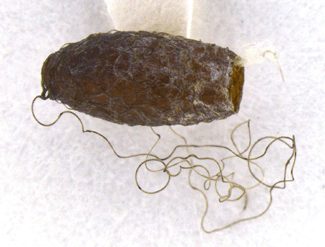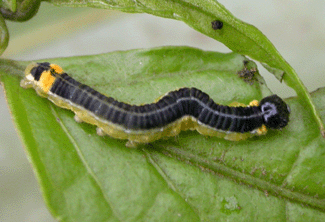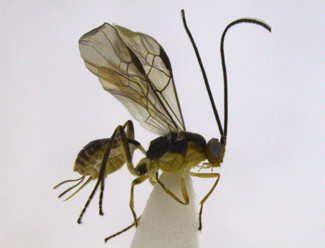LIFE HISTORY
DATA
|
Diagnostic features of adult
wasp
|
Body length 4.0-5.0 mm; head bright orange; mandible
strongly twisted; clypeus coarsely rugose and bulging;
occipital carina complete; wings clear; propodeum
areolate-rugose to rugose; hind coxa bi-colored, yellowish
white basally, brown to black apically; tarsal claw with
large basal lobe; dorsopes absent; ventral borders of first
metasomal tergite completely joined along basal ½ of
segment; ovipositor 1.7-2.0 x longer than first metasomal
tergite; tergite 2 often with white elongate-oval marking
extending onto base of tergite 1.
|
Biology and rearing
records
|
In Ecuador, Meteorus rugonasus has been reared
from second and third instar larvae of Pteronymia
zerlina (Hewitson) (Nymphalidae: Ithomiinae) feeding on
Solanum (Solanaceae). The parasitoid is a usually
solitary koinobiont endoparasitoid. More rarely, two have
been reared per host caterpillar. The pendant cocoon of the
wasp is suspended from a relatively short thread. This is
the only Meteorus species known to attack ithomiine
Nymphalidae.
|
Distribution
|
First discovered at the Yanayacu Biological Research
Station in Napo Province, Ecuador. The species also occurs
in subandean wet forests in Colombia. It is known from
elevations ranging from 730 to 2100 meters.
|
Similar species
|
Meteorus rugonasus is similar to Meteorus uno
(Zitani) and Meteorus oviedoi (Shaw and Nishida)
(both from Costa Rica). All three species have an orange
head, extensive black body markings, rugose clypeus, and
metasomal tergum 1 fused basally into a smooth tubular
petiole. But Meteorus rugonasus can be easily
distinguished by its more strongly bulging clypeus, its
unique association with ithomiine caterpillars, its
distribution in the Andean highlands, and color differences
as noted by Shaw and Jones (2009).
|
Comments
|
The species name rugonasus means "wrinkled nose"
in Latin, referring to the prominent, coarsely wrinkled
clypeus, which in lateral profile looks like a wrinkled
nose. It is also a play on words, since one might "wrinkle
one's nose" in response to a nasty chemical (the host
caterpillar is presumed to possess toxic alkaloids).
|
Reference
|
Shaw, S.R. and G.Z. Jones. 2009. A new species of
solitary Meteorus (Hymenoptera: Braconidae) reared
from caterpillars of toxic butterflies (Lepidoptera:
Nymphalidae) in Ecuador. Journal of Insect Science,
volume 9, article 34, pages 1-8. Available online:
insectscience.org/9.34.
Aguirre Fernandez, H., C.E. Sarmiento, and S.R. Shaw.
2011. Taxonomic revision and morphometric analysis of
Meteorus Haliday 1835 (Hymenoptera: Braconidae:
Meteorinae) from Colombia. Zootaxa 2938: 1-68.
|



